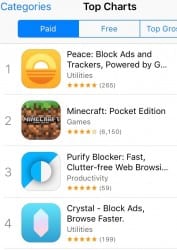Understanding the Ad Blockers
 It’s early in the morning and the alarm on my Pebble is letting me know it’s time to get up. I roll over, not quite ready to get up fully, and grab my phone on the nightstand.
It’s early in the morning and the alarm on my Pebble is letting me know it’s time to get up. I roll over, not quite ready to get up fully, and grab my phone on the nightstand.
I open up one of my news apps and begin looking at the day’s copyright news. I find a headline that looks interesting and, when I click the link, it opens the page up in my browser. However, before word one is read, the site loads a full page ad with a 15 second countdown timer that I can’t click past.
Even before my feet have touched the floor I’m already subjected to my first aggressive ad.
After putting myself together I head across the hall my office and start really working on the 3 Count. There, I made the mistake of clicking a site on my “banned” list, which takes me to a page that not only has a full page ad (this one fortunately easy to skip) but also begins autoplaying an unrelated video in the sidebar.
My first coffee is barely started and I’ve had my second teeth-gnashing ad experience.
Then, shortly after, I finally land on a site with more reasonable display ads, great for inclusion in the 3 Count. However, while the ads are definitely reasonable, one of the banners is for Amazon promoting Bluetooth headsets, which I had just recently bought one of on the site.
I shake my head and worry about my personal information, in particular my shopping history.
And so it goes, not just as I build my 3 Count, but as I go about my day. Whether I’m researching posts, working on projects or just browsing the Web, time and time again I run into annoying or questionable ads on the Web that stretch the limits of is acceptable to force upon visitors.
Though, as a supporter of creators and of copyright, I’m deeply against ad blocking. I would also be lying if I didn’t sympathize with ad blockers. While I don’t believe ad blocking is the solution, I do believe ad blockers have arguments that need to be heard.
Publishers, especially smaller ones, ignore these concerns at their own peril and it’s likely the only way that we can head off a seemingly inevitable war that will benefit no one.
The Ad Blocking Arguments
 I’ve talked at great length about the arguments for ad blockers before, but they do repair repeating, especially since they are relatively unchanged.
I’ve talked at great length about the arguments for ad blockers before, but they do repair repeating, especially since they are relatively unchanged.
The key arguments in favor of blocking ads include:
- Annoyance: Many ads are highly aggressive actively interfere with using the site. Ad blocking removes those.
- Bandwidth & Battery: Video and animated ads consume a great deal of bandwidth, which is often valuable, especially on mobile devices using a cellular connection. On some pages, blocking ads can remove more than 75% of the bandwidth. Also, animated ads can drain battery life, which is crucial on mobile and laptop devices.
- Privacy: Ad networks gather a great deal of information to better target ads to consumers. Many, understandably, are concerned about such a use of their private data and block ads to prevent it.
To be fair, these are all legitimate concerns. Though there were some who sought to block ads even when they were just static images, online advertising has gotten more aggressive in just about every respect. More animated, more customized, more annoying and simply just more of it.
There’s no doubt that surfing the web with an adblocker on is a better experience, just like there’s no doubt that visiting The Pirate Bay is cheaper than acquiring your movie legitimately. But where less than two percent of people in the U.S. pirate nearly all of their content (occasional or irregular piracy is much more common), in some U.S. states, nearly 15% of all people block all ads.
And that number is growing. Rapidly. According to one study, ad blocking is up 70% in just the last year and there’s no sign of the growth.
In fact, recent developments virtually guarantee that ad blocking is about to further exploding, reaching a platform it hasn’t made much headway on until recently.
The Rise of Mobile Ad Blocking
 The issue of ad blocking has come to a head recently because of a new feature in Apple’s iOS 9 that enables the installation of “content blockers” for Safari. Those blockers include ad blocking applications that will prevent mobile ads from showing.
The issue of ad blocking has come to a head recently because of a new feature in Apple’s iOS 9 that enables the installation of “content blockers” for Safari. Those blockers include ad blocking applications that will prevent mobile ads from showing.
Within 24 hours of release of iOS 9 three ad blockers made it to the top five paid apps in the App Store.
The problem is straightforward. Mobile ads, though not particularly successful to date, had been relatively safe from ad blocking.
Though ad blockers have long existed for Android, Google has actively prevented them from appearing in its Google Play store. Apple, on the other hand, has not only added the feature, but codified it by allowing several prominent ad blockers to operate.
The move by Apple opens up a whole new front on the ad blocking war. Though there have always been ways to block ads on mobile devices, such as ad blocking routers and simply rooting your device. Now, with iOS 9, it’s easy and free, even for a casual user.
For publishers, this is a nightmare. Though larger ones can fortify themselves with paid subscriptions and other streams of revenue, smaller ones are almost wholly dependent on advertising and will be the first to feel the pinch.
And now, the transition to mobile has gone from being a light at the end of the tunnel to an oncoming train. For publishers, it’s past time to realize that a collision is imminent and something will have to change sooner rather than later.
Publisher Options
 Online publishers are, in many ways, in a similar position to record labels and movie studios in the early 2000s. Users have found a way to gain access to your content without paying for it and are beginning to do so en masse, threatening all established business models.
Online publishers are, in many ways, in a similar position to record labels and movie studios in the early 2000s. Users have found a way to gain access to your content without paying for it and are beginning to do so en masse, threatening all established business models.
Publishers, much like those aforementioned labels, have three options:
- Fight It: Begin taking steps to combat ad blocking by denying content to those who block ads, similar to what Ars Technica did briefly in 2010. Going to war with ad blockers will make it less convenient and reduce its usefulness.
- Change Business Models: Begin experimenting with subscriptions and unblockable forms of advertising, such as sponsored content, to fill the shortfall. Other business models might help replace some of the lost revenue.
- Change Advertising: Finally, step away from the most egregious advertising practices and hope that ad blocking halts its growth or reverses course.
Obviously, these strategies are not mutually exclusive and any effective counter attack on ad blocking is likely going to involve bits of all three.
However, one thing it will not involve is a legal campaign. Unlike piracy, which is a very clear copyright infringement, ad blocking is not. Courts in Germany have ruled that Adblock, and similar services, are not committing copyright infringement. Likewise, rulings in the United States have found that Dish Network’s “Hopper” DVR, which automatically skips commercials, is not a copyright infringement either.
This means that publishers will have to find alternate routes to resolve this. They can seek out technological solutions to block the ad blockers and create new advertising revenue through impossible-to-block works, but any legal campaign will likely be ill-fated.
However, even if publishers do everything right, ad blocking is not going to go away. As with piracy, some will always choose the low road. However, by understanding why Adblocking is so popular, there is an opportunity to turn the tide, though it will mean admitting some very awkward truths.
Groking Ad Blocking
To repeat for clarity, I’m ethically against ad blocking. Not only do I think it’s a slight to creators who spend valuable time, money and expertise to create content for free consumption, but it also punishes the good actors along with the bad ones.
However, I’m also against it from a pragmatic standpoint as ad blocking also hurts ad blockers themselves, forcing publishers to worse forms of monetization with less editorial/advertising distinction. Once ads are blocked, the only response is to make it so that one can’t separate advertising from content.
Still, it’s easy to see why so many are turning to ad blocking. Online advertising is out of hand. So much so that even the CEO of Kargo, a mobile ad company, agrees that online advertising creates a “bad consumer experience” including annoyance, privacy and usability issues.
This is why, despite my opposition, this is an issue I can easily understand the views of the other side and find myself agreeing about the problem, just not the proposed solution.
Many publishers, for whatever reason, seem to fail to grok (deeply understand) these issues. As they work to squeeze more and more advertising dollars out of a site, they wonder why so many turn to ad blockers.
While setting up a good set of industry standards might help, it won’t solve the problem. On the Web, anyone can create a site and ignore any voluntary standards. Though adblockers could voluntary whitelist “well behaved” sites, such as what Adblock Plus does with the ads it allows, that process feels like extortion, especially when companies have to pay for the privilege.
That, in turn, is the problem. While major advertisers and sites getting on board will help, it won’t fix the problem. As long as annoying ads exist, some will block them along with the non-annoying ones.
Still, without really understanding the reasons people choose to block ads, publishers can’t hope to make a dent in the problem, which already seems to be running away from them.
Bottom Line
For me, I don’t run ad blockers day to day. I have an ad blocker installed that I do use when I do copyright enforcement work, both to avoid giving revenue to infringing sites and to improve security, but I don’t use it most of the time.
Instead, I personally fight back against annoying ads in two ways.
First, I uninstalled Flash on my main laptop. Flash, simply put, was taking up too much resources and causing too many problems, especially when I was using battery. Right now, Flash is only used on about 10% of all sites and that number is declining. Many sites that do use it have HTML5 alternatives that make the change barely noticeable.
The side benefit was that many of the autoplaying videos (though not all) and some of the most annoying ads are gone.
Second, I’ve been using the power of Plagiarism Today to try and not link to sites with aggressive ads. Both in the 3 Count and articles like this one, I try not to link to sites that have overly aggressive advertisements. It isn’t always possible, but I’m showing a strong preference to links that are less annoying both to provide my readers a better experience and to encourage the practice in other sites.
They’re small steps, but they are ways to encourage less annoying advertising practices without resorting to ad blocking.
In the end, what I want to see is both publishers thrive and readers get a great experience. However, that can’t happen as long as readers block ads and publishers fail to understand why they would do so.
Sure, understanding and fixing real problems won’t stop ad blocking, not any more than it’s stopped piracy, but it is a good first step and one that publishers need to take across the board before they completely lose control of the situation and their business model.
Want to Reuse or Republish this Content?
If you want to feature this article in your site, classroom or elsewhere, just let us know! We usually grant permission within 24 hours.
